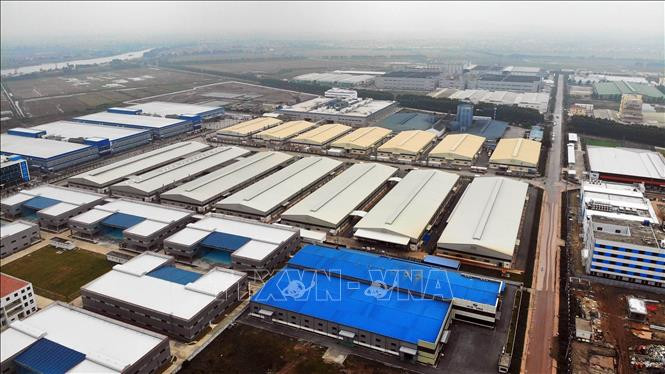The big advantage of the North is that the average price of industrial land is about 138 USD/m2, 20% lower than the South.

According to a report by the Ministry of Planning and Investment, the total registered foreign direct investment (FDI) in Vietnam in recent years shows that the manufacturing and processing industry accounts for more than 70% of the total FDI, reflecting the priority of investors in this sector. This not only brings direct economic benefits but also creates a spillover effect, promoting the development of related supporting industries and services.
Mr. Thomas Rooney, Senior Manager of Industrial Real Estate Department of Savills Hanoi commented that Vietnam is in a favorable position for production development activities. With its geographical location in the center of the Asia-Pacific region, Vietnam has become an ideal destination for import and export activities. In particular, the Northern region is becoming a leading bright spot in attracting investment in industrial real estate.
A survey by Savills Vietnam shows that in the Northern region, key provinces such as Bac Ninh, Hai Phong and Thai Nguyen are becoming the top destinations for FDI projects in the manufacturing sector. Bac Ninh, with its proximity to Hanoi and developed infrastructure, has attracted many large-scale projects from multinational corporations.
In the South, Binh Duong has also emerged as an important industrial center with the participation of many FDI enterprises in the manufacturing and processing sector. However, the North is still superior in terms of the number and scale of new projects thanks to advantages in costs, complete transport infrastructure, etc.
The big advantage of the North is that the average price of industrial land is about 138 USD/m2, 20% lower than in the South. Specifically, currently in the South, to rent strategic locations in tier 1 areas, such as Binh Duong or Ho Chi Minh City, land prices can be up to 300 USD/m2. Meanwhile, the Northern market only has an average price of 180 USD/m2 for tier 1 areas such as Bac Ninh.
In addition, the infrastructure in the North is considered to be strongly developed, with 10 completed highways and 4 other projects under implementation. Meanwhile, the South has about 7 highways.
According to Ms. Pham Thi Thu Trang, Senior Manager of Industrial Business Development at Core5 – Indochina Kajima, in Vietnam, road transport is still the main mode of transport, so the ability to move conveniently from production areas to consumer markets helps businesses optimize logistics costs. In particular, the highways connecting industrial zones with Hanoi and the Chinese border further increase the attractiveness of the North to foreign investors.
According to the plan, the North has more economic zones than the South; notably, the new coastal economic zone in Hai Phong with a scale of more than 20,000 hectares. The North also attracts investment thanks to its competitiveness in labor resources, as the average salary in the South is currently the highest in the country, at 9.3 million VND.
Compared to other countries in the region, experts say that Vietnam's industrial real estate market is witnessing strong developments. The exchange rate between VND and USD remains stable compared to other countries in the region, along with corporate income tax (CIT) incentives that are creating favorable conditions for Vietnam over competitors such as Malaysia and Indonesia. Notably, the Vietnamese Government is constantly introducing new CIT incentive policies to maintain this advantage.
According to data from the Asian Development Bank in 2024, Vietnam’s workforce is on average more than 32 years old, showing potential for future growth. At the same time, the wages that manufacturing workers in Vietnam receive are lower than in most other countries in the Southeast Asian region, except Indonesia. This is beneficial for Vietnam in attracting foreign investors, especially those businesses looking for low-cost production to optimize profits.
Notably, Vietnam has shifted its focus from low value-added industries to attracting high value-added manufacturing, thereby strengthening its position as an emerging market in the region. Vietnam is continuously demonstrating its competitiveness by shifting its orientation from an agricultural economy to an export-oriented economy, especially in the electronics and manufacturing sectors.
In fact, large technology corporations such as Samsung, LG, Intel, and Foxconn have played an important role in making Vietnam a regional electronics manufacturing hub. Recently, Foxconn's total investment in Vietnam has been raised to 1.5 billion USD with a factory project in Bac Giang serving the assembly and manufacturing of phone components. This also shows the trend of investing in high value-added industries in the Northern region.
In addition, free trade agreements (FTAs) also play an important role in attracting FDI to Vietnam. Since joining the World Trade Organization (WTO) in 1995, Vietnam has signed and implemented a series of trade agreements, of which the Vietnam - EU Free Trade Agreement (EVFTA) in 2019 has created a boom in foreign investment - Savills experts commented.
However, Mr. Thomas Rooney said that although Vietnam's industrial real estate market has great potential, one of the main challenges is still the shortage of skilled labor. This is especially important when Vietnam is aiming to increase the added value in the manufacturing industry.
Currently, although the labor force is abundant, especially in the North, the majority of workers are still low-skilled. To overcome this problem, reforming education and training to improve labor skills is necessary - Mr. Thomas Rooney recommended.
At the same time, infrastructure development is also an important factor to enhance Vietnam's competitiveness. Currently, infrastructure projects being implemented are mainly concentrated in some areas, but need to be expanded and developed synchronously nationwide.
In particular, improving the transport network connecting industrial zones and consumer markets will help optimize logistics costs, creating favorable conditions for businesses. Strong infrastructure will not only support the movement and transportation of goods but also enhance the ability to attract foreign investment to Vietnam.